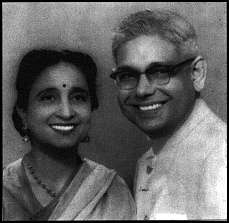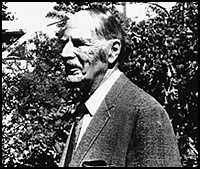

Dr. Haridas and Bina Chaudhuri
As with all beginnings, all histories, the seeds which bore the fruit of the California Institute of Integral Studies had been planted long before. After the end of the Second World War there was much discussion about the "meeting of East and West." In 1951, Louis Gainsborough, a successful businessman-- seeking to create an opportunity for Eastern and Western scholars to come together to study the fundamentals of Eastern culture, philosophy, yoga, psychology and literature-- created the American Academy of Asian Studies in San Francisco. Gainsborough invited Dr. Frederic Spiegelberg, then Professor of Indic and Slavic Studies at Stanford University, to be director of his new Academy. Dr. Spiegelberg, who was researching The Living Spirituality of India on a Fulbright grant, had visited every guru, swami, and ashram possible. When he eventually received darshan from Sri Aurobindo-- the poet, philosopher, political activist and sage of India-- he described it as "a transforming experience." He was delighted to take part in this exciting new venture.
Spiegelberg invited Alan Watts, who was then chaplain at Northwestern, to come to San Francisco to join the Academy. He also invited a number of other scholars from India, Tibet, and Japan. He wanted to bring to America an Indian professor who was well-versed in both Eastern and Western philosophy and who also had a special knowledge of Sri Aurobindo's integral philosophy. Dr. Spiegelberg wrote Sri Aurobindo, asking him to recommend someone who was an authoritative exponent of integral philosophy and yoga, and also conversant with Western philosophy. Aurobindo replied, "The best man I can recommend is Haridas Chaudhuri."
Haridas Chaudhuri was born in Bengal in 1913. At the age of 14 he had his first profound spiritual experience, which caused him to reformulate his entire outlook on life and become a serious student of spiritual philosophy. He studied both Eastern and Western philosophy at Calcutta University, and visited the Pondicherry ashram several times. Although he met Sri Aurobindo only once through darshan, he established a deep and meaningful communication with him through letters. Dr. Chaudhuri, then chairman of the Department of Philosophy at Krishnagar College in West Bengal, joined the staff at the Academy as Professor of Indian Philosophy and Comparative Religion in 1951.
Commenting on Frederic Spiegelberg's invitation asking him to teach at the American Academy of Asian Studies, Dr. Chaudhuri said,
As I was reading Dr. Spiegelberg's letter, I immediately felt it was the call of destiny. My entire life appeared to me in a flash and revealed its hidden meaning.
Courses at the Academy covered all aspects of Asian culture, including area studies of the Far East, South Asia, and the Middle East, focusing on the philosophies, religions, socio-political systems, and main languages of these regions. The early days were characterized by lively intellectual debate. Of this time, Michael Murphy, who was a student at the time and who later co-founded Esalen Institute, recalled:
One of the great events of those early days was a colloquium held every Friday night that was chaired by Frederic Spiegelberg, Alan Watts and Haridas Chaudhuri. You had to get there about an hour early to get into the room... the electricity was really enormous.
Alan Watts recalled:
Spiegelberg invited Sir C.P. Ramaswamy Aiyar, ... Chancellor of the University of Banarasa-- a princely man, close to seventy, who somehow reminded one of the elephant god Ganesha. There was also Tokwan Tada, a Japanese lama trained in Tibet, who brought with him the entire Buddhist canon in Tibetan wood-block prints.
While excited by the idea of integrating Eastern thought into Western education, Dr. Chaudhuri was disheartened to find widespread misunderstanding of Indian/Asian/Oriental culture. By way of illustrating this lack of understanding, he once related the following story.
Let me relate here a little incident from my own personal experience. It was at San Francisco in May, 1951. 1 was waiting for a public bus at a street corner. An elderly man watched me from a distance and approached with the friendly inquiry.- "Are you a yogi?" I paused to think for a while what might be his notion of a yogi and why he took me for one... but he did not wait for my reply. He produced his palm before me and said "Would you care to read my palm and tell me whether I have any good luck in the near future? The other day I bought a good lottery ticket, you know."
So, in 1951, in order to educate the public about Asian culture, the Cultural Integration Fellowship (CIF) was founded to celebrate the fundamental unity and values of all cultures and religions. It was Rudolph Schaeffer, founder of the Rudolph Schaeffer School of Design and a practitioner of yoga and meditation, who made space available at his East-West Arts Gallery for Dr. Chaudhuri to give public lectures; in 1956 the CIF moved to its present location on Fulton Street.
Dr. Schaeffer expressed his generosity in other ways as well. He graciously took Haridas and Bina Chaudhuri into his home when they first came here from India; and in 1985 he donated a ceramic Tang Dynasty horse to the Institute, the proceeds from which have been used to establish the Rudolph Schaeffer Chair in Art and Creativity Studies at CIIS.
CIAS Becomes A Reality
When the American Academy of Asian Studies began to dissolve, Dr. Chaudhui felt that an entirely new entity had to be formed-- not only to recreate the original inspiration and mandate, but to expand. The Cultural Integration Fellowship expanded its educational programs, and from 1968 to 1974, the California Institute of Asian Studies was the educational branch of CIF. In 1974 CIAS was incorporated separately as a private, non-sectarian, non-profit graduate school.
At a landmark commencement ceremony in 1972, the Institute celebrated the 100th anniversary of Aurobindo's birth, as well as the news that CIAS had just received "Approval for Candidacy" status as a step toward accreditation from the Western Association of Schools and Colleges.
As the California Institute for Asian Studies grew, the Chaudhuris moved out of their 21st Street home and the building was used for classes and Offices; for larger classes, the Cultural Integration Fellowship generously provided space. A building on Church Street was acquired when additional space was needed. The Church Street building currently houses one of the Institute's counseling centers; the other is located on Pierce Street.
In the years following, the school's focus on Asian and Buddhist studies continued, while additional Programs in integral studies were created. A program in integral psychology and counseling drew on many fields of psychology which represent aspects of the total human experience, including the physical, emotional, mental, and spiritual. Today the Institute offers an MA in Integral Counseling and a Ph.D. in Psychology.
A course of study in East-West Psychology brought the philosophical and psychological disciplines of both East and West to the study of consciousness and social interaction. Eastern and Western views of human nature, based on ancient spiritual practices, were integrated with the theories and findings of contemporary psychologies. The program today offers a master's and doctoral program. Also formalized during these years was a focus on comparative Philosophy and Religion, which engaged the unity and diversity found with in the major traditions of the East and the West. Students in the M.A and Ph.D. programs today continue to develop an appreciation of human responses to the ultimate questions of life and nature.
After Dr. Chaudhuri's death in 1975, Bina Chaudhuri, along with dedicated staff, faculty and students, carried on his vision.
To assist in making this difficult transition, Frederic Spiegelberg, the original director of the American Academy of Asian Studies, returned to the institution he had helped to found 25 years earlier, and became the second president of the California Institute of Asian Studies, serving from 1976-1978.

Frederic Spiegelberg as President of the
California Institute of Asian Studies, 1976
From CIAS to CIIS
Dr. Chaudhuri believed that the institute would eventually be accredited, the Board would be enriched, the student body would grow, and that the Institute would locate in a place of its own with space for all.
-- Rina Sircar
In 1980, the Institute's Board of Governors voted to change the name of the school from the California Institute of Asian Studies to the California Institute of Integral Studies to reflect the expanding scope of integral studies at the school. The Institute's use of the term integral stems from the integral yoga of Sri Aurobindo, who appreciated both Eastern and Western intellectual and spiritual traditions, and from Dr. Chaudhuri's integral philosophy, which was profoundly influenced by Aurobindo. Integral studies seek and express a unifying vision of humanity, nature, world, and spirit. Integral studies at the school also emphasize the importance of integrating all aspects of learning: the intellectual, the experiential, and the applied.
In April, 1981, the accreditation of the CIIS by the Western Association of Schools and Colleges became official. In January 1991, the Institute received a grant for $5 million from Laurance S. Rockefeller. In the words of Michael Murphy," ... this gift is historical and probably represents the single largest gift of its kind to a spiritual organization." In January 1999 the Institute moved to its new home at 1453 Mission Street.
Back to The Early History of the California Institute of Integral Studies
California Institute of Integral Studies
Website
Cultural Integration Fellowship
Website